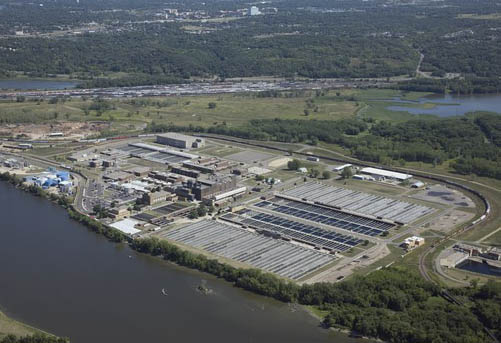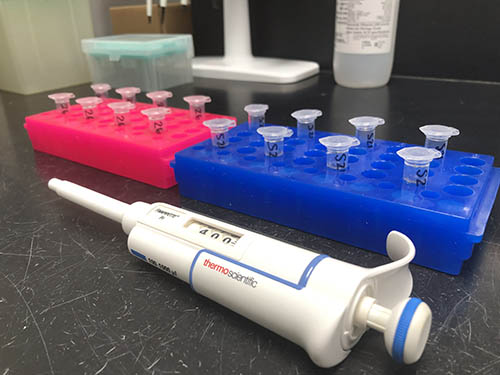The Metropolitan Council continues its work to learn more about COVID-19 infection rates and trends from clues found in — of all places — wastewater.
The Met Council’s Environmental Services division collects and treats wastewater for the metro area. Scientists there say the research they’re doing with colleagues at the University of Minnesota Genomics Center (UMGC) could help predict COVID-19 outbreaks in the metro area even before testing can identify positive cases.
This could become one more tool to help public health officials make informed policy decisions to reduce and prevent future spread.
“The water entering a wastewater treatment plant contains information we can piece together to help assess the health of the population the plant serves,” said Steve Balogh, a Met Council principal research scientist. “By studying the contents of wastewater, we get an indication of the prevalence of the disease and how it is trending over time.”

Remnants of SARS-CoV-2 genetic material are extracted from wastewater
In response to the pandemic, Environmental Services research and development staff repurposed a lab at the large Metropolitan Wastewater Treatment Plant in Saint Paul. There, they quickly learned to extract the genetic material of the virus that causes COVID-19 from untreated wastewater samples. This extracted material is not the active virus itself; rather it is a remnant of the SARS-CoV-2 viral particles that COVID-19 patients release into wastewater through their bodily wastes.
“The material we collect is the single-stranded RNA (ribonucleic acid) that the virus uses to reproduce inside infected cells. If you’re infected with COVID-19, the viral particles attach to your cells, get inside them, and use the RNA to reproduce and spread the virus,” Balogh said.
“We extract the RNA from wastewater, transferring it to clean water, and immediately freeze the samples in small vials at minus 112 degrees Fahrenheit. Then we deliver the vials to the UMGC for analysis to quantify traces of the SARS-CoV-2 virus using advanced analytical instruments. The amount of viral RNA we observe is a measure of the prevalence of COVID-19 in our service area,” said Balogh.
Wastewater could give health officials a warning about infection surges
Current research suggests that people may start shedding the virus in their feces up to five days before symptoms appear.
What researchers at Met Council and the UMGC have found is that the concentrations of the virus in wastewater, to date, closely mirror the changing infection rates in the metro area, where the Metro Plant treats the wastewater of about 70 percent of the region’s population, approximately 175 million gallons a day.
“The possibilities are really exciting,” said George Sprouse, manager of process engineering, research and development, and air quality for Environmental Services. “Right now, health officials rely on COVID-19 testing to tell us what’s happening with disease spread. Wastewater-based epidemiology, however, might offer an earlier indication of the emergence and spread of infection.
“This could give public health officials more time to anticipate a spike in caseloads and plan accordingly,” said Sprouse.
“Wastewater surveillance may not replace testing and physical exams, but we think it could offer another data source for health officials and decision-makers,” said Kenny Beckman, UMGC director. “We have a lot to learn yet and the science is still evolving, but the Met Council has done a great job of designing pioneering studies and their results are extremely promising. We look forward to continued collaboration.”

Trying to keep up with a mutating virus
The virus that causes COVID-19, SARS-CoV-2, is reportedly changing and mutating in ways that may make it more contagious.
Working with the UMGC, Met Council recently began trying to “sequence” the viral RNA, that is, determining the sequence of molecular subunits that comprise the RNA chain. This could allow scientists to better understand how the virus is changing locally and whether new, possibly more transmissible strains are showing up in our community.
“The COVID-19 virus has many strains or variants,” said Sprouse. “If we can capture and evaluate the “fingerprint” of the viral RNA in wastewater, we might have an indicator of the prevalence of new strains in our region, such as the one found recently across the United Kingdom.”
Sprouse says this is a very new area of research, with a steep learning curve, but a worthy effort if it can help to save lives through early detection and mitigation.
Met Council contributes wastewater samples to state, national initiatives
In addition to these efforts, Met Council is also involved in state and national initiatives to evaluate wastewater surveillance as a tool for tracking the spread of the virus.
Since May 2020, Met Council has sent wastewater samples to the University of Minnesota-Duluth as part of an effort to monitor the virus in wastewater treatment plants across Minnesota. As a result of an expansion of the project in September, Met Council is currently sending samples to Duluth from all nine of its treatment plants twice a week. This project is expected to continue through September 2021.
In addition, Met Council was recently selected to participate in the first phase of a national Wastewater Surveillance System. The Centers for Disease Control and Prevention (CDC) and U.S. Department of Health and Human Services (HHS) are collaborating with municipalities across the nation to examine how wastewater-based epidemiology can assist our response to the COVID-19 pandemic.
Select wastewater utilities serving 10% of the U.S. population — including Met Council — were invited to participate in the first phase.
“This is a means of information sharing to help public health officials better understand the extent of COVID-19 infections in communities throughout the U.S.,” said Balogh.
“From January 4 through February 10, we will send twice-weekly wastewater samples to a lab in Arizona for the first phase of this national initiative. With this project, the federal government has affirmed the potential public health benefits of wastewater-based epidemiology. We’re pleased to be a part of it.”